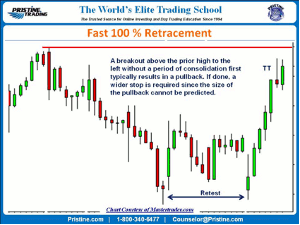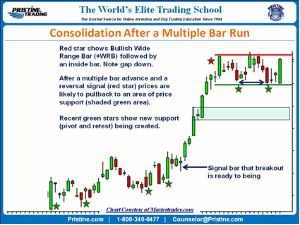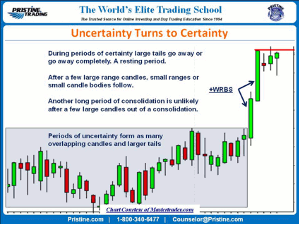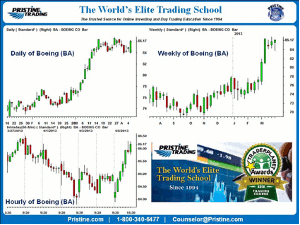Mastering how to use price action in multiple times frames will increase your trading profits, writes Greg Capra of Pristine Capital Holdings, Inc.
A breakout occurs when prices are able to clear a prior price area that has been a point of resistance in the past. But this doesn't mean all breakouts are the same. A breakout can occur after a decline that is followed by a period of whippy consolidation-that in time "tightens up." It can occur in one fast move from a low to and above a prior high. Not the ideal entry. It can also occur after a rally that is followed by a period of consolidation. Consolidations can happen in various forms, a base being the most widely used. Ideally, a tight base or a tightening in the last few bars occurs just prior to the breakout. Let's review some examples.
Chart of Fast 100 % Retracement
In the above example,
prices began to move up after a retest of the prior low and rallied all the way
back up to the prior resistance area. The second to last candle that formed was
a topping tail (TT) that signaled that sellers are focused on the prior high
area-resistance. However, the next candle ignored the TT, or in other words,
buyers continued to step up regardless of the prior resistance area; a bullish
sign.
Prices could continue higher above the prior high and the supply of shares there. But without a small period of consolidation that would display buyers "absorbing" that supply, the likelihood of a retracement into the prior rally is high. Absorbing that supply reduces the possibility of a breakout failure. Some buyers that own shares from lower prices are going to sell at resistance after such a move. If prices move above the prior high without a stalling first, many more are going to cash in on the quick profit.
Buying a breakout after a straight through rally above the prior high from a low can be done, but not without a stop-loss based on the move. The size of the stop and share-size must take into consideration the retracement that is more than likely to occur.
Chart After a Multiple Bar Run
In the above example,
prices rallied from a base after the signal bar formed. The initial move stalled
for moment (shaded area) where the opens and closes of the three candles are
overlapping. These overlapping opens and closes are a base on a lower time
frame. This is where buyers will step up on a pullback, should that occur. That
pullback did not occur here, rather buyers continued to step up above that level
and form a new pivot low; a bullish sign. That low provided a new support
reference point that was taken advantage of on the rested.
NEXT PAGE: Uncertainty Turns to Certainty
|pagebreak|The last bar engulfed the most recent candles, which is bullish and tells us that buyers are anticipating a breakout above the recent resistance. Large bullish engulfing bars like the one seen are typically followed by a smaller candle or candles. Typically doesn't mean always, especially with this pattern since the bullish bar came after a period of consolidation and retest.
Chart of Uncertainty Turns
In this example, prices broke
out of a whippy consolidation and while there were clues that shares were being
accumulated, there was no clear signal bar of the breakout occurring at that
moment as there was in the prior example. This long period of uncertainty was
followed by two bullish wide range bars (+WRB) signaling huge increase in buyers
and higher prices.
Fast, igniting moves like this create a void of price support below. However, this pattern (two +WRBs out of a consolidation) is less likely to correct by pulling back since the move began from a consolidation. It is also less likely for prices to base or consolidate for a long time for the same reason. The last candle in the pattern actually signals the low of the correction after the +WRBs and higher prices-a breakout-will follow soon.
Charts of All
I have shown you the same stock
Boeing (BA)
in different time frames and explained how to interpret the price movement in
those time frames. Traders using these time frames or others could potentially
enter BA on
signals that come together at the same time. This is what makes for explosive
moves when they happen. However, each could also enter at different times
depending how the patterns developed from here. For example, the traders using
the weekly time frame could enter on the next candle's move above the high,
which could happen immediately. To the trader on the hourly time frame that
entry would not be ideal since there is no clear reference support level to use
as stop-loss because of the straight up momentum move. Also, such a move would
certainly setup other new entry points in the hourly time frame or other lower
ones.
All traders can have the same bias, but entering at very different times. All entries can be right for that trader in their time frame of choice with confirming price patterns.
Intra-day traders use signals from higher time frames for a bias and then trade signals (price patterns) in a lower time frame in alignment with that bias.
I hope this Chart of the Week (COTW) has given you what we call a "light bulb moment." The understanding of price movement in multiple times frames and how to use them will increase your investing, swing trading, and day trading profits.
By Greg Capra, President & CEO, Pristine Capital Holdings, Inc.






















